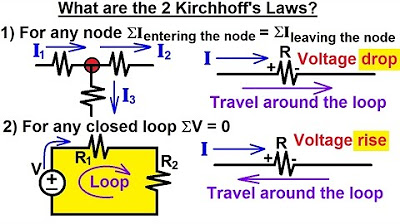Kirchhoff's Current Law (KCL)
Summary
TLDRThis lecture introduces Kirchhoff's Current Law (KCL), one of two important laws formulated by German physicist Gustav Kirchhoff. KCL states that the algebraic sum of currents entering any node in a circuit is zero. The speaker explains that this is based on the conservation of charge, meaning the sum of entering currents must equal the sum of leaving currents. An example is provided where currents are categorized as entering (positive sign) or leaving (negative sign) to illustrate the concept. The lecture concludes by highlighting how KCL ensures that no charge is stored, generated, or destroyed at a node.
Takeaways
- 🔬 Kirchhoff's Laws are fundamental in electrical circuit analysis, with Kirchhoff's Current Law (KCL) being the first law discussed.
- 🌐 KCL states that the algebraic sum of currents entering any node in a circuit is zero.
- 📊 Algebraic sum refers to the total considering the direction of the currents, with entering currents as positive and leaving currents as negative.
- 📚 The convention for currents is that entering currents are marked with a positive sign, and leaving currents with a negative sign.
- 🔄 Example given in the script illustrates how the algebraic sum of currents at a node equals zero, following the convention.
- 🚫 Nodes cannot store charge, generate, or destroy it, adhering to the law of conservation of charge.
- ⚖️ The algebraic sum of currents being zero is a result of the law of conservation of charge and the fact that nodes are not circuit elements.
- 💡 The sum of entering currents must equal the sum of leaving currents, as charge cannot be stored or generated at a node.
- 🔋 The movement of charge is what constitutes current, reinforcing that the algebraic sum of currents at a node must be zero.
- 📅 The next lecture will cover Kirchhoff's Voltage Law (KVL), which is the second fundamental law in circuit analysis.
Q & A
Who formulated Kirchhoff's laws?
-Kirchhoff's laws were formulated by Gustav Kirchhoff, a German physicist.
What are the two Kirchhoff's laws?
-The two Kirchhoff's laws are Kirchhoff's Current Law (KCL) and Kirchhoff's Voltage Law (KVL).
What does Kirchhoff's Current Law (KCL) state?
-Kirchhoff's Current Law (KCL) states that the algebraic sum of the currents entering any node is zero.
How do you calculate the algebraic sum of currents according to KCL?
-You calculate the algebraic sum of currents by aggregating the currents with regard to their signs, where entering currents have a positive sign and leaving currents have a negative sign.
What convention is followed for current signs in KCL?
-In KCL, the convention is that entering currents have a positive sign and leaving currents have a negative sign.
Can you give an example of applying KCL to a node?
-Yes, if a node has five currents where I1, I3, and I4 are entering (positive sign) and I2 and I5 are leaving (negative sign), then I1 + I3 + I4 = I2 + I5, and their algebraic sum equals zero.
Why is the algebraic sum of currents at a node equal to zero?
-The algebraic sum of currents at a node is zero because a node cannot store, generate, or destroy charge, according to the law of conservation of charge.
What would happen if the number of charges entering a node were greater than the number of charges leaving it?
-If more charges enter a node than leave it, it would imply charge storage at the node, which is not possible. Therefore, the sum of entering charges must equal the sum of leaving charges.
What does the movement of charge represent in electrical terms?
-The movement of charge represents the current.
What will be discussed in the next lecture following the discussion on KCL?
-The next lecture will discuss Kirchhoff's Voltage Law (KVL).
Outlines

This section is available to paid users only. Please upgrade to access this part.
Upgrade NowMindmap

This section is available to paid users only. Please upgrade to access this part.
Upgrade NowKeywords

This section is available to paid users only. Please upgrade to access this part.
Upgrade NowHighlights

This section is available to paid users only. Please upgrade to access this part.
Upgrade NowTranscripts

This section is available to paid users only. Please upgrade to access this part.
Upgrade NowBrowse More Related Video

Electrical Engineering: Basic Laws (8 of 31) What Are Kirchhoff's Laws?

KVL and KCL (Circuits for Beginners #11)

Chapter 2 - Fundamentals of Electric Circuits

Aula 2. Leis De Kirchhoff Exercício 1

Electrical Engineering: Basic Laws (11 of 31) Kirchhoff's Laws: A Medium Example 2

Cara Pintar | Memahami Hukum Kirchoff
5.0 / 5 (0 votes)